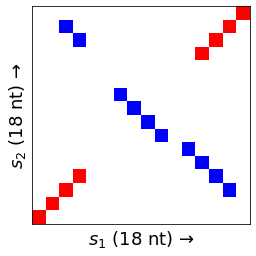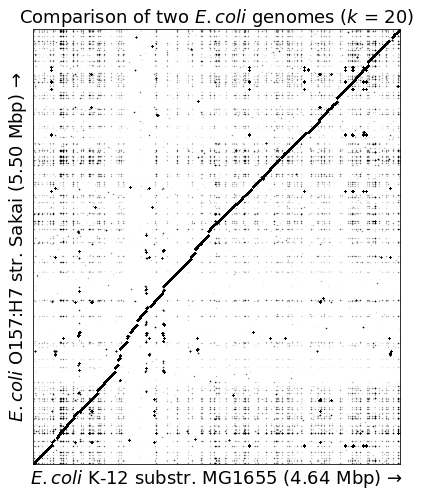Small library for creating and visualizing dot plot matrices
Project description
wotplot
wotplot is a small Python library for creating and visualizing dot plot matrices.
Quick examples
Small dataset
This example is adapted from Figure 6.20 (bottom right) in Bioinformatics Algorithms, edition 2.
import wotplot
# Define our dataset
s1 = "AGCAGGAGATAAACCTGT"
s2 = "AGCAGGTTATCTACCTGT"
k = 3
# Create the matrix (the "binary" parameter means we'll distinguish forward,
# reverse-complementary, and palindromic matching k-mers from each other)
m = wotplot.DotPlotMatrix(s1, s2, k, binary=False)
# Convert the matrix to dense format and visualize it using matplotlib's
# imshow() function (for large matrices where dense representations are
# impractical, use viz_spy() instead; see below)
wotplot.viz_imshow(m)
In the default colorscheme red cells (🟥) indicate forward matches, blue cells (🟦) indicate reverse-complementary matches, and purple cells (🟪) indicate palindromic matches.
Larger dataset: comparing two E. coli genomes
Using E. coli K-12 (from this assembly) and E. coli O157:H7 (from this assembly). I removed the two plasmid sequences from the O157:H7 assembly.
import wotplot
from matplotlib import pyplot
# (skipping the part where I loaded the genomes into memory as e1s and e2s...)
# Create the matrix (leaving binary=True by default)
em = wotplot.DotPlotMatrix(e1s, e2s, 20, verbose=True)
# Visualize the matrix using matplotlib's spy() function
fig, ax = pyplot.subplots()
wotplot.viz_spy(
em, markersize=0.01, title="Comparison of two $E. coli$ genomes ($k$ = 20)", ax=ax
)
ax.set_xlabel(f"$E. coli$ K-12 substr. MG1655 ({len(e1s)/1e6:.2f} Mbp) \u2192")
ax.set_ylabel(f"$E. coli$ O157:H7 str. Sakai ({len(e2s)/1e6:.2f} Mbp) \u2192")
fig.set_size_inches(8, 8)
More detailed tutorial
Please see this Jupyter Notebook.
Installation
wotplot supports Python ≥ 3.6. You can install it and its dependencies using pip:
pip install git+https://github.com/fedarko/wotplot.git
I'll try to put this on PyPI / conda eventually.
Performance
Optimizations made so far
I've tried to make this library reasonably performant. The main optimizations include:
-
We use suffix arrays (courtesy of the lovely
pydivsufsortlibrary) in order to reduce the memory footprint of finding shared k-mers. -
We store the dot plot matrix in sparse format (courtesy of SciPy) in order to reduce its memory footprint.
-
We support visualizing the dot plot matrix's nonzero values using matplotlib's
spy()function, which (at least for large sequences) is faster and more memory-efficient than converting the matrix to a dense format and visualizing it with something likeimshow().
That being said...
This library could be made a lot more efficient (I've been documenting ideas in issue #2), but right now it's good enough for my purposes. Feel free to open an issue / make a pull request if you'd like to speed it up ;)
Informal benchmarking
See this Jupyter Notebook for some very informal benchmarking results performed on a laptop with ~8 GB of RAM.
Even on this system, the library can handle reasonably large sequences: in the biggest example, the notebook demonstrates computing the dot plot of two random 100 Mbp sequences (using k = 20) in 54 minutes and 12.45 seconds. Dot plots of shorter sequences (e.g. 100 kbp or less) usually take only a few seconds to compute, at least for reasonably large values of k.
Why does this library exist?
-
This library separates the creation and visualization of dot plot matrices. Other tools that I tried produced pretty visualizations, but didn't give me easy access to the underlying matrix.
-
I wanted something that worked well with matplotlib, so that I could create and tile lots of dotplots at once in complicated ways.
Setting up a development environment
First, fork wotplot. Then you can download a copy of the code from your fork and install wotplot from this code.
The following commands should work on a Unix system; this assumes that you have Python ≥ 3.6 and pip installed.
git clone https://github.com/your-github-username-goes-here/wotplot.git
cd wotplot
pip install -e .[dev]
Contact
Feel free to open an issue if you have questions, suggestions, comments, or anything else.
Project details
Release history Release notifications | RSS feed
Download files
Download the file for your platform. If you're not sure which to choose, learn more about installing packages.















